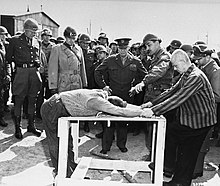Ohrdruf concentration camp
| |||||||||||||||||||||||
Read other articles:

Ancient Greek settlement in Turkey GryneiumShown within TurkeyLocationYeni Şakran, Izmir Province, TurkeyRegionAeolisCoordinates38°52′28″N 27°4′9″E / 38.87444°N 27.06917°E / 38.87444; 27.06917TypeSettlement Gryneium or Gryneum or Gryneion (Ancient Greek: Γρύνειον), also Grynium or Grynion (Γρύνιον), Grynia or Gryneia (Γρύνεια) and Grynoi (Γρῦνοι),[1] was a city of ancient Aeolis. It was located 40 stadia from Myrina and 70…

16 digit identifier for people and organisations This article relies excessively on references to primary sources. Please improve this article by adding secondary or tertiary sources. Find sources: International Standard Name Identifier – news · newspapers · books · scholar · JSTOR (December 2015) (Learn how and when to remove this message) International Standard Name IdentifierLogo used by ISNIAcronymISNIOrganisationISNI-IAIntroducedMarch 15, 2…

Chronologies Chronologie du sport 1975 1976 1977 1978 1979 1980 1981Mois :Jan - Fév - Mar - Avr - Mai - Juin Juil - Aoû - Sep - Oct - Nov - Déc 1977 ◄◄ 1978 en sport ►► 1979 Chronologie dans le monde 1975 1976 1977 1978 1979 1980 1981Décennies :1940 1950 1960 1970 1980 1990 2000Siècles :XVIIIe XIXe XXe XXIe XXIIeMillénaires :-Ier Ier IIe IIIe Chronologies géographiques Afrique Afrique du Sud, Algérie,…

Sceaux 行政国 フランス地域圏 (Région) イル=ド=フランス地域圏県 (département) オー=ド=セーヌ県郡 (arrondissement) アントニー郡小郡 (canton) 小郡庁所在地INSEEコード 92071郵便番号 92330市長(任期) フィリップ・ローラン(2008年-2014年)自治体間連合 (fr) メトロポール・デュ・グラン・パリ人口動態人口 19,679人(2007年)人口密度 5466人/km2住民の呼称 Scéens地理座標 北緯48度46�…

American singer Walter JacksonBackground informationBirth nameWalter JacksonBorn(1938-03-19)March 19, 1938Pensacola, Florida, United StatesDiedJune 20, 1983(1983-06-20) (aged 45)Chicago, Illinois, United StatesGenresSoul, R&B, Chicago soulOccupation(s)singerYears active1959–1983LabelsColumbia, OKeh, Cotillion, Brunswick, Chi Sound, Kelli-ArtsMusical artist Walter Jackson (March 19, 1938 – June 20, 1983)[1] was an American soul ballad singer who had a string of hits on the US…

Atomwaffen DivisionFront de résistance national socialiste[1] Idéologie Néonazisme[2]AntisémitismeNéofascisme[2]Suprémacisme blancAnticapitalisme[3]HomophobieAccélérationnisme[2]Nazisme ésotérique (en)Nationalisme blancAnticommunismeMillénarianisme (en)FuturismeSatanisme ONA (factions internes)[2]Djihad blanc[4] Positionnement politique Extrême droite Objectifs Renversement du gouvernement fédéral des États-Unis par le terrorisme et la guérilla Instigation d'un nettoyag…

Award given by the Sangeet Natak Akademi Sangeet Natak Akademi AwardAward for contributions to Performing artsAwarded forAward for performing arts in IndiaSponsored bySangeet Natak AkademiFirst awarded1952Last awarded2023Websitewww.sangeetnatak.gov.in/award-honours/ratna-awards ← Sangeet Natak Akademi Fellowship Tyagaraju known for his extensive contributions to Carnatic music. Music of India Genres Traditional Classical Carnatic Odissi Hindustani Folk Borgeet Baul Bhajan Kirtana Shya…

1999 film by Andrew Fleming DickTheatrical release posterDirected byAndrew FlemingWritten by Andrew Fleming Sheryl Longin Produced byGale Anne HurdStarring Kirsten Dunst Michelle Williams Dave Foley Harry Shearer Dan Hedaya CinematographyAlexander GruszynskiEdited byMia GoldmanMusic byJohn DebneyProductioncompany Phoenix Pictures Distributed byColumbia Pictures (through Sony Pictures Releasing)Release date August 4, 1999 (1999-08-04) Running time94 minutesCountries Canada[1 …

Chronologies Données clés 1260 1261 1262 1263 1264 1265 1266Décennies :1230 1240 1250 1260 1270 1280 1290Siècles :XIe XIIe XIIIe XIVe XVeMillénaires :-Ier Ier IIe IIIe Chronologies thématiques Religion (,) et * Croisades Science () et Santé et médecine Terrorisme Calendriers Romain Chinois Grégorien Julien Hébraïque Hindou Hégirien Persan Républicain modifier Années de la santé et de la médecine : 1…

2003 video gameTraitors Gate 2: CypherDeveloper(s)258 Productions AB, Data Ductus ABPublisher(s)The Adventure CompanyPlatform(s)WindowsReleaseNA: October 28, 2003[1]EU: 2004Genre(s)Graphic adventure gameMode(s)Single-player Traitors Gate 2: Cypher is a 2003 graphic adventure game developed by Swedish studios 258 Productions AB and Data Ductus AB and published by The Adventure Company. It is the sequel to Daydream Software's game Traitors Gate. Gameplay This section needs expansion. You c…

Tanacetum parthenium Klasifikasi ilmiah Kerajaan: Plantae (tanpa takson): Angiospermae (tanpa takson): Eudikotil (tanpa takson): Superasterid (tanpa takson): Asterid Ordo: Asterales Famili: Asteraceae Genus: Tanacetum Spesies: T. parthenium Nama binomial Tanacetum parthenium(L.) Sch. Bip. Tanacetum parthenium (Inggris: Feverfew, Jerman: Mutterkraut) adalah tumbuhan semak dari keluarga Asteraceae. Tumbuhan ini tingginya 30–80 cm dan mempunyai bau yang mirip bau jeruk nipis. Daun tanam…

علم الجمهورية الإسبانية الثانية. فترة السنتين التاليتين من الجمهورية الإسبانية الثانية وسميت أيضًا فترة السنتين التصحيحية أو فترة السنتين المحافظة أو فترة الإصلاح المضاد، وسميت أيضًا فترة السنتين السوداوين على اليسار، وهي فترة من الجمهورية الثانية ظهرت بين الانتخابات ال…

G.O.D지오디Kiri ke kanan: Son Ho-young, Yoon Kye-sang, Kim Tae-woo, Danny Ahn dan Park Joon-hyungInformasi latar belakangAsal Korea SelatanGenreK-popR&B[1]Tahun aktif1999 (1999)–sekarangLabelSidusHQ/CJ E&M (2014–sekarang)JYP Entertainment (2003–2005)SidusHQ (1999–2003)[2]Artis terkaitJYP NationAnggota Park Joon-hyung Yoon Kye-sang Danny Ahn Son Ho-young Kim Tae-woo G.O.D (Hangul: 지오디, akronim untuk Groove Over Dose[3]) adalah se…

هذه المقالة تحتاج للمزيد من الوصلات للمقالات الأخرى للمساعدة في ترابط مقالات الموسوعة. فضلًا ساعد في تحسين هذه المقالة بإضافة وصلات إلى المقالات المتعلقة بها الموجودة في النص الحالي. (أغسطس 2022) توسع الأوعية الدموية للقرنية (CNV) معلومات عامة الاختصاص طب العيون من أنواع الت…

Canadian figure skater Karen MagnussenMagnussen in 1974Full nameKaren Diane Magnussen-CellaBorn (1952-04-08) April 8, 1952 (age 72)Vancouver, British Columbia, CanadaHeight160 cm (5 ft 3 in)[1]Figure skating careerCountryCanadaSkating clubNorth Shore Winter ClubRetired1977 Medal record Representing Canada Figure skating: Ladies' singles Winter Olympics 1972 Sapporo Singles World Championships 1973 Bratislava Singles 1972 Calgary Singles 1971 Lyon Singles North A…

Indian government think tank NITI AayogGovernment Agency overviewFormed1 January 2015; 9 years ago (2015-01-01)Preceding Government AgencyPlanning CommissionJurisdictionGovernment of IndiaHeadquartersNew DelhiAnnual budget₹400.65 crores (US$48+ million) (2020–21)[1] including Ministry of PlanningGovernment Agency executivesNarendra Modi, ChairpersonSuman Bery, Vice ChairpersonB. V. R. Subrahmanyam, CEOParent Government AgencyMinistry of PlanningWebsitewww.niti.gov.i…

Study of the relationship of body size to shape, anatomy, physiology, and behavior Skeleton of an elephantSkeleton of a tiger quoll (Dasyurus maculatus).The proportionately thicker bones in the elephant are an example of allometric scaling Allometry is the study of the relationship of body size to shape,[1] anatomy, physiology and behaviour,[2] first outlined by Otto Snell in 1892,[3] by D'Arcy Thompson in 1917 in On Growth and Form[4] and by Julian Huxley in 1932…

This article relies largely or entirely on a single source. Relevant discussion may be found on the talk page. Please help improve this article by introducing citations to additional sources.Find sources: JTEKT – news · newspapers · books · scholar · JSTOR (April 2019) JTEKT Corporation 株式会社ジェイテクトCompany typePublic (K.K)Traded asTYO: 6473FoundedJanuary 2006; 18 years ago (2006-01)HeadquartersOsaka, JapanKey peopl…

Niigata Sangyo University Niigata Sangyo University (新潟産業大学, Niigata sangyō daigaku) is a private university in Kashiwazaki, Niigata, Japan. The predecessor of the school was founded in 1947. It was chartered as a junior college in 1950 and became a four-year college in 1988. External links Official website (in Japanese) 37°20′4.2″N 138°35′34.5″E / 37.334500°N 138.592917°E / 37.334500; 138.592917 Authority control databases International ISNI VIAF…

هذه المقالة يتيمة إذ تصل إليها مقالات أخرى قليلة جدًا. فضلًا، ساعد بإضافة وصلة إليها في مقالات متعلقة بها. (يوليو 2021) جمعية المصورين التشغيليين تعديل مصدري - تعديل جمعية المصورين التشغيليين (بالإنجليزية: Society of Operating Cameramen)[1] (SOC) تأسست الجمعية في عام 1979 تحت اسم جمعية الم�…











